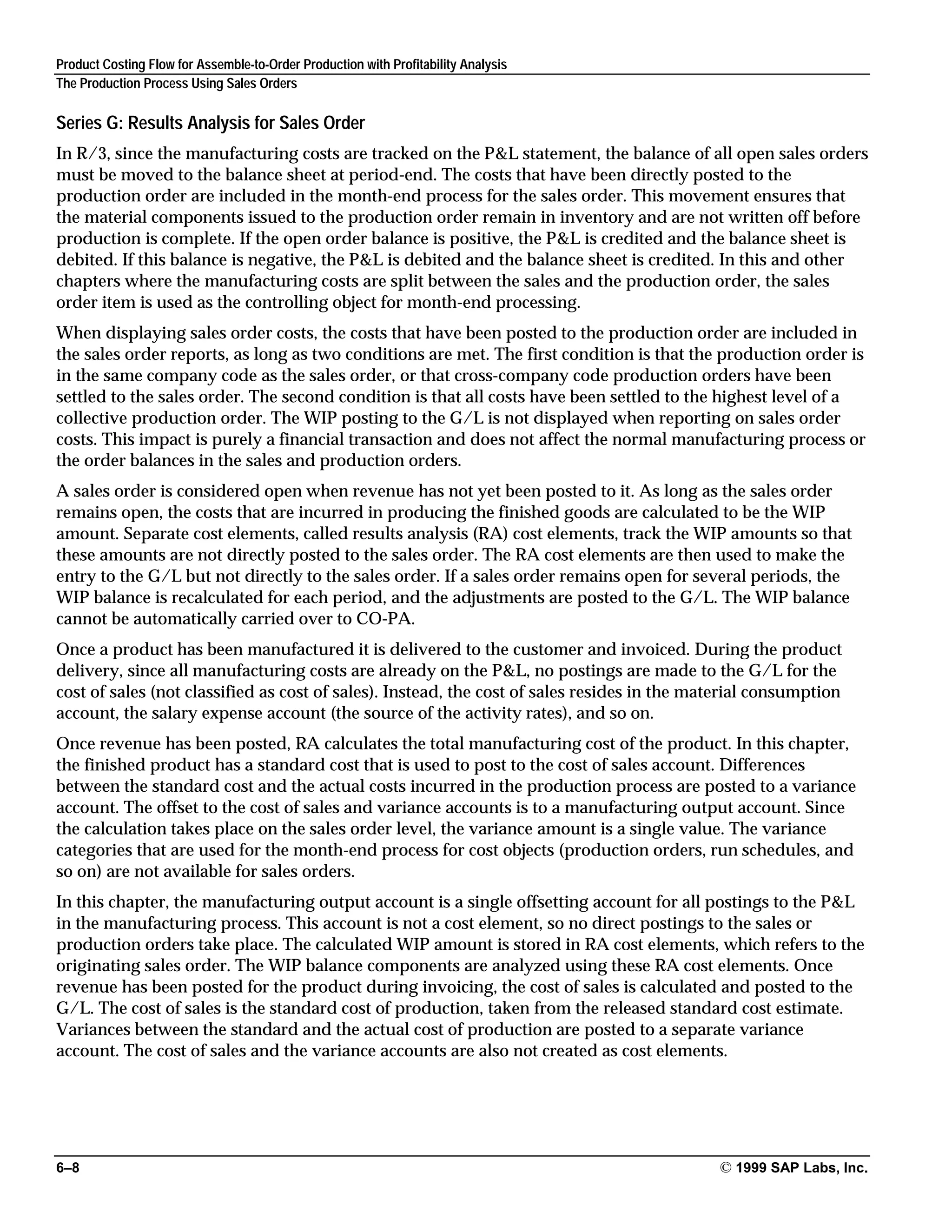This document describes product costing scenarios in SAP R/3 for different types of manufacturing processes. It includes scenarios for discrete manufacturing without and with profitability analysis, as well as make-to-order production with valuated stock and profitability analysis. For each scenario, it provides an overview of the production process and month-end processing, and illustrates the flow through financial and cost accounting using T-accounts. It also discusses design decisions and issues related to cost-based profitability analysis.



























































































































































































![Work-In-Process and Results Analysis
List of Configuration Transactions
C–2 © 1999 SAP Labs, Inc.
dictates a specific, methodical approach be used for the month-end process and for mid-month pro-forma
statements.
From a high-level perspective, using discrete manufacturing with production orders as an example, to
calculate WIP and settlement to G/L:
1. Calculating overhead with costing sheets (if used)
2. Calculating WIP
3. Calculating variances
4. Order Settlement
(Other tasks such as monthly allocations or assessments are not included in this appendix.) Step 2 may be
considered the program that computes the WIP values and stages them for subsequent processing. Step 4
is the program that actually posts these values to the G/L.
With this perspective as a general background to the process, the rules used to calculate the value of WIP
and settle it to the G/L are defined in several RA tables in configuration. Because different manufacturing
methods, such as discrete vs repetitive vs MTO, require different costing techniques, the configuration of
Cost Object Controlling contains sections appropriate to each. However, many tasks are simply different
views of the same underlying tables. For discrete manufacturing, production orders are found under the
Order related production section. (Do not confuse this with sales order-related, which is for MTO
manufacturing).
To provide a quick-reference guide to the “typical” configuration for the various methods, a general
explanation of the configuration tables is shown, followed by a matrix to identify the appropriate table
settings and their impact. Bear in mind that that RA is designed to support a wide variety of techniques,
and there may be alternative settings depending on the circumstances. In all cases, the full configuration
should be thoroughly tested with integrated scenarios to ensure all requirements are met.
List of Configuration Transactions
• RA Key (transaction OKG1)
The key is simply a name that groups together various control parameters on how to compute WIP. As
delivered, the required keys already exist. This table is simply a list. There is no drill-down in this
screen.
• RA Versions (transaction OKG2 or OKG9)
Important control parameters on whether to pass WIP to FI, whether calculations are done uniquely by
RA key, some of the secondary cost elements used, etc.
• Valuation Method Order-Related [actual (transaction OKGC)]
Settings on exactly how to compute WIP, if using the actual costs option based on order status. This
method only accrues for costs actually incurred. This was the only method prior to Release 3.0, and is a
common choice.
• Valuation Method Order-related/Repetitive [plan (transaction OKGD)]
Settings used to compute WIP, if using the planned cost option in orders or run schedules. The planned
cost option assumes standard values are earned based on progress through the task list (routing). This
method is also known as reporting points. In repetitive manufacturing this implies the possibility of](https://image.slidesharecdn.com/product-costing-made-easy-in-sap-220221164623/75/Product-costing-made-easy-in-sap-188-2048.jpg)











































![Overhead
Task List Method
E–10 © 1999 SAP Labs, Inc.
Task List for Material x – Operation #10 – Detail screen
Std value Un Activity Type
Setup 30 MIN SetupHr
Machine 60 MIN MachHr
Labor 60 MIN LabHr
Vbl Ovhd .25 --- VblOvh02
Data Relationships Diagrams
The following graphics illustrate the data relationships:
Work Center
Formula: [(Vbl Ovhd * Machine time) * Activity type
price] / Base quantity
(e.g. = .25 * 60 min * $50/hr per unit processed in this
op)](https://image.slidesharecdn.com/product-costing-made-easy-in-sap-220221164623/75/Product-costing-made-easy-in-sap-232-2048.jpg)























